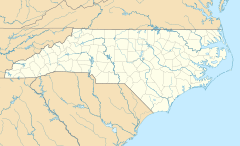Navassa, North Carolina facts for kids
Quick facts for kids
Navassa, North Carolina
|
||
|---|---|---|
|
||
| Motto(s):
"People Working For People"
|
||
| Country | United States | |
| State | North Carolina | |
| County | Brunswick | |
| Area | ||
| • Total | 13.79 sq mi (35.71 km2) | |
| • Land | 13.33 sq mi (34.52 km2) | |
| • Water | 0.46 sq mi (1.19 km2) | |
| Elevation | 23 ft (7 m) | |
| Population
(2020)
|
||
| • Total | 1,367 | |
| • Density | 102.57/sq mi (39.60/km2) | |
| Time zone | UTC-5 (Eastern (EST)) | |
| • Summer (DST) | UTC-4 (EDT) | |
| ZIP code |
28451
|
|
| Area codes | 910, 472 | |
| FIPS code | 37-46060 | |
| GNIS feature ID | 2406968 | |
Navassa is a small town in Brunswick County, North Carolina, United States. It is located near the city of Wilmington. In 2020, about 1,367 people lived there.
Contents
The town of Navassa got its name from Navassa Island. A post office was opened here in 1903. Navassa officially became a town in 1977.
Navassa is located along the Brunswick and Cape Fear rivers. These rivers are important waterways in North Carolina.
The town covers about 35.8 square kilometers (13.8 square miles). Most of this area is land, with a small part being water.
The area around Navassa and the Cape Fear River is known for having many different kinds of plants and animals. It is considered a very rich area for biodiversity in the United States.
This region has 50 different types of natural homes, called habitats. These habitats support about 300 different kinds of plants and animals. Twenty-two of these species are endemic, which means they are found only in this specific area and nowhere else in the world.
Experts have studied the plants and animals here. They looked at important natural areas, rare species, and good places for birds and other wildlife. They also studied the rivers and creeks, looking for healthy fish populations and clean water.
Fish Life Cycle: Anadromous Fish
Some fish in Navassa's waters are called anadromous. This means they are born in the fresh water of the town's creeks and rivers. They then swim out to the sea (the Atlantic Ocean) and spend most of their lives there. When it's time to have their own babies, they return to the fresh waters of Navassa to lay their eggs.
Wetlands and Rare Plants
The marshes along the Cape Fear River and Brunswick River near Navassa are a large area of tidal marshes. These marshes are wet, grassy areas where the water level changes with the tides. They are home to many tall grasses and wildflowers.
One special plant found here is the Carolina Bishop Weed. This is the only known place in North Carolina where this plant grows. Another important area is Sturgeon Creek, which has a rare plant called Cypress Knee Sedge. These natural areas are very important for protecting unique plant and animal life.
| Historical population | |||
|---|---|---|---|
| Census | Pop. | %± | |
| 1980 | 439 | — | |
| 1990 | 445 | 1.4% | |
| 2000 | 479 | 7.6% | |
| 2010 | 1,505 | 214.2% | |
| 2020 | 1,367 | −9.2% | |
| 2023 (est.) | 1,737 | 15.4% | |
| U.S. Decennial Census | |||
In 2020, the town of Navassa had 1,367 people living there. There were 704 households and 385 families.
Population Details from 2020
The population of Navassa in 2020 included people from different backgrounds. About 57.6% of the residents were Black or African American. Around 27.9% were White. Other groups, including Native American, Asian, Pacific Islander, and people of mixed races, made up smaller parts of the population. About 10.2% of the people were Hispanic or Latino.
Population Details from 2010
In 2010, Navassa had 1,505 people. About 63.6% of the population was African American, and 27.1% was White. Other groups made up the rest. About 3.8% of the people were Hispanic or Latino.
The town's population was spread out by age. About 27.3% were under 18 years old. About 14.2% were 65 years or older. The average age in Navassa was 37 years old.
The town of Navassa has a special cultural history, especially linked to the Gullah-Geechee culture.
What is Gullah-Geechee Culture?
The Gullah people are African Americans who live along the southeastern coast of the United States. This area stretches from North Carolina down to Florida. They have a unique culture, language, and way of life that has been kept alive since the 1700s.
In southeastern North Carolina, many Gullah people today are direct descendants of enslaved people. These ancestors worked on rice and peanut farms in the Cape Fear River valley. Many residents of Navassa have a direct connection to this culture. In the past, there were five different rice farms in the area that is now Navassa. After the farming system changed, the enslaved people who worked on these farms eventually settled in the area.
Preserving the Heritage
In 2006, the U.S. Congress created the Gullah-Geechee Cultural Heritage Corridor. This corridor helps to protect and teach people about this important culture. It shows how important the Gullah-Geechee culture is to American history. The Mayor of Navassa even helps lead the committee that works to preserve this heritage.
See also
 In Spanish: Navassa (Carolina del Norte) para niños
In Spanish: Navassa (Carolina del Norte) para niños



